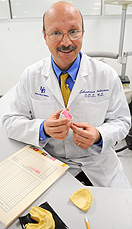Close Up
Implant center draws researcher back
-
 Print
Print -
 Comments
Comments
-

Sometimes we have a different perception of people because we do not know and/or understand their background.”
To hear Sebastiano Andreana talk about cooking, culture and why he loves Buffalo, you might forget for the moment that he’s an accomplished researcher with a hectic schedule and a long list of responsibilities.
Andreana was a member of the UB dental faculty for more than a decade before moving to New Jersey in July 2005 to join Pfizer Consumer Healthcare (later Johnson & Johnson) and then to California to become a professor of periodontics at Loma Linda University School of Dentistry. In December 2008, Andreana and his wife, Carla Beneduce, B.A. ’02, both natives of Rome, Italy, returned to Buffalo and UB. The reasons were twofold: He relished the opportunity to direct a new Center in Dental Implants, while also serving as associate professor in the Department of Restorative Dentistry in the dental school. The couple also wanted to return to a city they’d grown to love for its warmth, livability and four seasons.
Implant dentistry, Andreana explains, “is a successful clinical approach to replace missing teeth. Nowadays, it is an excellent treatment option for dental patients who want to restore their oral functions.” Through surgical interventions, trained clinicians insert a titanium fixture or screw, which resembles the tooth root, into the bone. After a certain time, the bone and the titanium become one apparatus. At a later stage, an artificial tooth, or crown, is placed on top of the titanium screw to complete the process.
Boding well for UB’s future in dental implantology, Andreana says, are results of a retrospective study he co-authored with Beneduce and Robert Buhite, UB clinical associate professor of restorative dentistry, of all dental implants done at the UB dental school between 1997 and 2004. Of those implants, 97.5 percent were successful, Andreana reports of the study published recently in the New York State Dental Journal. “This is excellent! It’s even better when you consider that the majority of these patients had some medical issues and were of a more mature age.”
Andreana hopes to build on this promising foundation to create at UB the more coordinated and centralized approach that is part of leading implantology programs at other universities. The new center will emphasize hands-on training in implantology for dental students and other professionals in the field. Besides strengthening the collaboration with other departments within the dental school, Andreana also will seek support from industry in the form of partnerships.
Away from the lab and classroom, Andreana enjoys several hobbies, especially cooking. His description of how he prepares Italian gourmet dishes is mouth-watering, as is his account of why he chooses to cook with local, fresh ingredients and avoid prepared food. “My wife and I grew up with the idea that fresh ingredients are the secret for a healthy and tasty dish, and so we start from scratch,” he says. “Prepared food is just not how we were brought up in Italy.”
Andreana and his wife also are keenly interested in Native-American cultures, and blend this interest with oral care education initiatives for Native Americans, in particular children, both in Western New York and when they were in California.
Proud of his heritage, Andreana is active in Buffalo’s Dante Alighieri Italian Cultural Club. But he also likes to share food and experiences with those from other cultural backgrounds. During his previous UB tenure, he organized several international nights for the dental school’s own polyglot community, an activity he plans to resume—supported by the school’s administration. This involvement in cultural sharing affords simple pleasure—“I truly enjoy it,” he says. But it also springs from his curiosity about other people and their way of life.
“Sometimes we have a different perception of people because we do not know and/or understand their background,” he says. “Say I meet a person from Colombia—what do I know about Colombia? So I would say to him or her, ‘tell me about your country.’”

Reader Comments